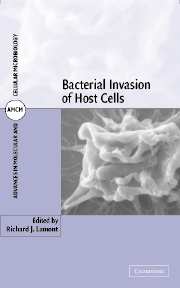Book contents
- Frontmatter
- Contents
- Contributors
- Preface
- Bacterial Invasion of Host Cells
- 1 Invasion mechanisms of Salmonella
- 2 Shigella invasion
- 3 How Yersinia escapes the host: To Yop or not to Yop
- 4 Stealth warfare: The interactions of EPEC and EHEC with host cells
- 5 Molecular ecology and cell biology of Legionella pneumophila
- 6 Listeria monocytogenes invasion and intracellular growth
- 7 N. gonorrhoeae: The varying mechanism of pathogenesis in males and females
- 8 Group A streptococcal invasion of host cells
- 9 Invasion of oral epithelial cells by Actinobacillus actinomycetemcomitans
- 10 Invasion by Porphyromonas gingivalis
- Index
- Plate section
- References
7 - N. gonorrhoeae: The varying mechanism of pathogenesis in males and females
Published online by Cambridge University Press: 21 August 2009
- Frontmatter
- Contents
- Contributors
- Preface
- Bacterial Invasion of Host Cells
- 1 Invasion mechanisms of Salmonella
- 2 Shigella invasion
- 3 How Yersinia escapes the host: To Yop or not to Yop
- 4 Stealth warfare: The interactions of EPEC and EHEC with host cells
- 5 Molecular ecology and cell biology of Legionella pneumophila
- 6 Listeria monocytogenes invasion and intracellular growth
- 7 N. gonorrhoeae: The varying mechanism of pathogenesis in males and females
- 8 Group A streptococcal invasion of host cells
- 9 Invasion of oral epithelial cells by Actinobacillus actinomycetemcomitans
- 10 Invasion by Porphyromonas gingivalis
- Index
- Plate section
- References
Summary
Neisseria gonorrhoeae, the gonococcus, is the causative agent of gonorrhea, one of the oldest human diseases on record. Biblical references to gonorrhea in Leviticus (15:1–15:19) showed that the infectious nature of the disease was recognized even at that time. Probably, the best description of gonorrhea in a man in the preantibiotic era can be found in the writings of Boswell, who described in detail each of his 19 episodes of infection (Ober, 1970). These descriptions also allude to the asymptomatic nature of the disease in women, as many of the contacts from whom he acquired the infection were without symptoms of disease. Today, it is estimated that greater than 1 million cases of N. gonorrhoeae infection occur in the United States, and 60 million cases are reported annually worldwide. Hence, N. gonorrhoeae infection remains prevalent in the general population, despite the fact that antibiotic therapy is readily available. The high incidence of this disease remains a major concern in lower socioeconomic groups in the United States; however, the highest incidence of infection and of complications resulting from infection occur in developing countries. In underdeveloped nations it has been shown that patients with gonorrhea are at much higher risk for contracting human immunodeficiency virus (HIV). It is proposed that this increased susceptibility to HIV infection results from the inflammatory response generated by infecting gonococci with the subsequent disruption and shedding of the mucosal epithelium.
- Type
- Chapter
- Information
- Bacterial Invasion of Host Cells , pp. 203 - 238Publisher: Cambridge University PressPrint publication year: 2004
References
- 1
- Cited by



